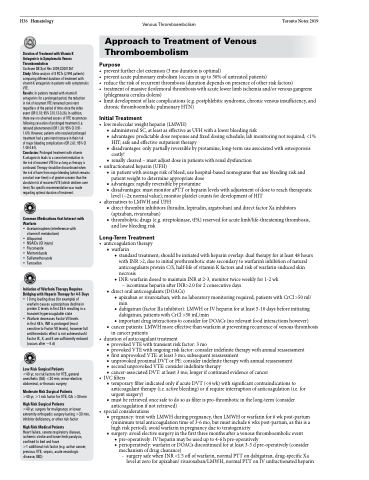Page 576 - TNFlipTest
P. 576
H36 Hematology
Venous Thromboembolism
Toronto Notes 2019
Duration of Treatment with Vitamin K Antagonists in Symptomatic Venous Thromboembolism
Cochrane DB Syst Rev 2009;CD001367
Study: Meta-analysis of 8 RCTs (2,994 patients) comparing different durations of treatment with vitamin K antagonists in patients with symptomatic VTE.
Approach to Treatment of Venous Thromboembolism
Purpose
• preventfurtherclotextension(3modurationisoptimal)
• preventacutepulmonaryembolism(occursinupto50%ofuntreatedpatients)
• reduce the risk of recurrent thrombosis (duration depends on presence of other risk factors)
• treatmentofmassiveileofemoralthrombosiswithacutelowerlimbischemiaand/orvenousgangrene
(phlegmasia cerulea dolens)
• limitdevelopmentoflatecomplications(e.g.postphlebiticsyndrome,chronicvenousinsufficiency,and
chronic thromboembolic pulmonary HTN)
Initial Treatment
• lowmolecularweightheparin(LMWH)
■ administered SC, at least as effective as UFH with a lower bleeding risk
■ advantages: predictable dose response and fixed dosing schedule; lab monitoring not required; <1%
HIT; safe and effective outpatient therapy
■ disadvantages: only partially reversible by protamine, long-term use associated with osteoporosis
costly!
■ renally cleared – must adjust dose in patients with renal dysfunction
• unfractionatedheparin(UFH)
■ in patient with average risk of bleed; use hospital-based nomograms that use bleeding risk and
patient weight to determine appropriate dose
■ advantages: rapidly reversible by protamine
■ disadvantages: must monitor aPTT or heparin levels with adjustment of dose to reach therapeutic
level (~2x normal value); monitor platelet counts for development of HIT • alternativestoLMWHandUFH
■ direct thrombin inhibitors (hirudin, lepirudin, argatroban) and direct factor Xa inhibitors (apixaban, rivaroxaban)
■ thrombolytic drugs (e.g. streptokinase, tPA) reserved for acute limb/life-threatening thrombosis, and low bleeding risk
Long-Term Treatment
• anticoagulationtherapy ■ warfarin
◆ standard treatment; should be initiated with heparin overlap: dual therapy for at least 48 hours with INR >2, due to initial prothrombotic state secondary to warfarin’s inhibition of natural anticoagulants protein C/S, half-life of vitamin K factors and risk of warfarin-induced skin necrosis
◆ INR: warfarin dosed to maintain INR at 2-3, monitor twice weekly for 1-2 wk – iscontinue heparin after INR>2.0 for 2 consecutive days
■ direct oral anticoagulants (DOACs)
◆ apixaban or rivaroxaban; with no laboratory monitoring required, patients with CrCl >50 ml/
min
◆ dabigatran (factor IIa inhibitor): LMWH or IV heparin for at least 5-10 days before initiating
dabigatran, patients with CrCl >30 mL/min
◆ important drug interactions to consider for DOACs (no relevant food interactions however)
■ cancerpatients:LMWHmoreeffectivethanwarfarinatpreventingrecurrenceofvenousthrombosis in cancer patients
• durationofanticoagulanttreatment
■ provoked VTE with transient risk factor: 3 mo
■ provoked VTE with ongoing risk factor: consider indefinite therapy with annual reassessment ■ first unprovoked VTE: at least 3 mo, subsequent reassessment
■ unprovoked proximal DVT or PE: consider indefinite therapy with annual reassessment
■ second unprovoked VTE: consider indefinite therapy
■ cancer-associated DVT: at least 3 mo, longer if continued evidence of cancer
• IVCfilters
■ temporary filter indicated only if acute DVT (<4 wk) with significant contraindications to
anticoagulant therapy (i.e. active bleeding) or if require interruption of anticoagulation (i.e. for
urgent surgery)
■ must be retrieved once safe to do so as filter is pro-thrombotic in the long-term (consider
anticoagulation if not retrieved) • specialconsiderations
■ pregnancy: treat with LMWH during pregnancy, then LMWH or warfarin for 6 wk post-partum (minimum total anticoagulation time of 3-6 mo, but must include 6 wks post-partum, as this is a high risk period); avoid warfarin in pregnancy due to teratogenicity
■ surgery: avoid elective surgery in the first three months after a venous thromboembolic event
◆ pre-operatively: IV heparin may be used up to 4-6 h pre-operatively
◆ perioperatively: warfarin or DOACs discontinued for at least 3-5 d pre-operatively (consider
mechanism of drug clearance)
- surgerysafewhenINR<1.5offofwarfarin,normalPTTondabigatran,drug-specificXa
Results: In patients treated with vitamin K antagonists for a prolonged period, the reduction
in risk of recurrent VTE remained consistent regardless of the period of time since the index event (OR 0.18; 95% CI 0.13-0.26). In addition, there was no observed excess of VTE recurrences following cessation of prolonged treatment (i.e. rebound phenomenon) (OR 1.24; 95% CI 0.91- 1.69). However, patients who received prolonged treatment had a persistent increase in their risk
of major bleeding complications (OR 2.61; 95% CI 1.48-4.61).
Conclusion: Prolonged treatment with vitamin
K antagonists leads to a consistent reduction in
the risk of recurrent VTE for as long as therapy is continued. Therapy should be discontinued when the risk of harm from major bleeding (which remains constant over time) is of greater concern than the absolute risk of recurrent VTE (which declines over time). No specific recommendation was made regarding optimal duration of treatment.
Common Medications that Interact with Warfarin
• Acetaminophen (interference with
vitamin K metabolism)
• Allopurinol
• NSAIDs (GI injury)
• Fluconazole
• Metronidazole
• Sulfamethoxazole
• Tamoxifen
Initiation of Warfarin Therapy Requires Bridging with Heparin Therapy for 4-5 Days
• 10 mg loading dose (for example) of
warfarin causes a precipitous decline in protein C levels in first 36 h resulting in a transient hypercoagulable state
• Warfarin decreases Factor VII levels
in first 48 h, INR is prolonged (most sensitive to Factor VII levels), however full antithrombotic effect is not achieved until Factor IX, X, and II are sufficiently reduced (occurs after ~4 d)
Low Risk Surgical Patients
<40 yr, no risk factors for VTE, general anesthetic (GA) <30 min, minor elective, abdominal, or thoracic surgery
Moderate Risk Surgical Patients
>40 yr, >1 risk factor for VTE, GA >30 min
High Risk Surgical Patients
>40 yr, surgery for malignancy or lower extremity orthopedic surgery lasting >30 min, inhibitor deficiency, or other risk factor
High Risk Medical Patients
Heart failure, severe respiratory disease, ischemic stroke and lower limb paralysis, confined to bed and have
>1 additional risk factor (e.g. active cancer, previous VTE, sepsis, acute neurologic
disease,IBD)
level at zero for apixaban/ rivaroxaban/LMWH, normal PTT on IV unfractionated heparin


